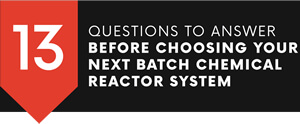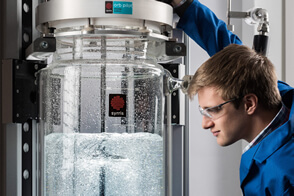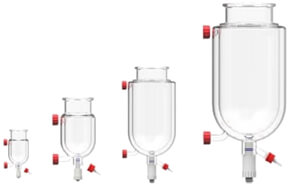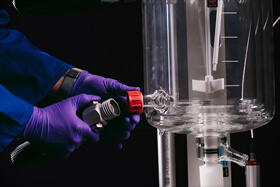Download the Infographic here!
Or continue to read on to learn about all the burning questions you need to ask before choosing your next Chemical Reactor System.
If you need any help, you can contact us today to discuss your chemistry needs and we will be happy to help you!
Contact Us Today! |
An article by Dr. Stephen Heffernan, Batch Chemistry Applications Specialist for Syrris
- What is your application, how do you currently perform your chemistry (if at all), and what do you want to achieve with your new chemical reactor?
The application may determine the kind of reactor system you need – e.g. round-bottom flasks or jacketed reactors – and may help determine the level of sophistication needed in that system – e.g. complex chemistry, such as hydrogenation, can determine the type of system you need.

How you currently achieve your application helps you identify where improvements could be made. For example, if you’re currently manually switching between multiple gases in a reaction, choosing a reactor system that offers a gas selection module would enable you to switch between multiple pre-pressurised gases at the touch of a button, offering an immediate improvement in usability and reliability of results.
The complexity of your chemistry will also play a part. Simple and/or short reactions may require a manual jacketed reactor system, whereas chemists performing complex chemistry with multiple steps will see a big advantage in choosing an automated jacketed reactor system that provides complex, multi-step automation.
- What working volumes do you want to use?
Do you need a wide vessel range? Tiny vessels (e.g. 50 mL), large, pilot-scale vessels (e.g. 50 L), or somewhere in-between? Your working volume range – for current applications and possible future needs – will affect what type of chemical reactor system you choose.
- What temperature range do you want to cover?
The temperature range of your application – and possible future applications – will have a big impact on your decision. Hot plates may be sufficient, or you may need a jacketed reactor with a circulator. Hotplate/solid state heaters may be sufficient, but if your application requires reliable low temperatures or a wider temperature range you may need a jacketed reactor with a circulator.

- What viscosity are your typical reactor contents?
Ensuring your stirrer motor is up to the job of effectively stirring your reactor contents is of utmost importance. Are your contents particularly viscous? Do you require torque feedback information? Is there a certain stirrer speed you need to achieve?
- What vessel geometry do you need?
A number of vessel geometries are available for batch reactor systems, including round-bottom, dish, and torispherical geometries, in a range of L/D ratios. Do you need vessels that mimic large-scale production reactors, or a reactor that mimics smaller scale round-bottom flasks?
- What stirrer geometry do you need?
Do you need high or low shear mixing? Are you stirring particulates? Stirrer elements greatly affect the efficiency and type of mixing you can achieve in a batch reactor. So, your decision is largely based on what you’ll be stirring and what you want to achieve in your reactor.
Magnetic stirrers are generally used for nonviscous liquids of up to a couple of liters in volume, but larger volumes, viscous liquids, and liquids for which viscosity changes, will generally require overhead stirrer motors and stirrer elements.
|
Stirrer element |
Uses, benefits, and limitations |
|---|---|
|
Anchor stirrer |
Anchor stirrers ensure minimum deposits on vessel walls and even distribution of high mineral content in liquids, therefore ideal for mixing polymer reactions. Anchor stirrers are ideal for stirring liquids at low speeds, stirring liquids with medium to high viscosity, providing high shearing forces at edges, and creating tangential flow. |
|
Pitched Blade Radial (PBT) stirrer |
PBT impellers provide a combination of both radial and axial flow and generates high shear levels, provides excellent mixing ability, and easy cleanup. Its simple design makes it cost-effective in large scale and high viscosity applications. |
|
Retreat Curve Impeller |
General/multiple purpose mixing, high pumping volume, low to medium viscosity, low volume, radial flow. |
- Do you need to work under pressure/vacuum?
The vacuum and/or pressure requirements of your application(s) will help determine the type of chemical reactor system you need. What is the maximum pressure you wish to work at? What level of vacuum do you want to reach? Pressure systems will require additional safety features to ensure user safety (e.g. burst discs and pressure relief valves).

- Do you perform reaction calorimetry?
Understanding the thermal properties of a reaction is such an incredibly hot topic (pun intended), especially when scaling up your process, that it is worth considering your calorimetry requirements before investing in a new chemical reactor. Do you want a discrete calorimetry system or a multi-use reactor system that can be used for both your chemistry and calorimetric testing?
- What chemicals/solvents are you using?
Are there any reagents/solvents you use that are particularly corrosive/volatile? Are there any particular materials that will react with your reactor system? Does the reactor system have appropriate safeguards in place to protect itself from your chemistry, ensuring the longevity of your system?
- Do you need reagent addition?
Are you currently adding small quantities of reagents to your reaction over long periods, or dosing corrosive/harmful chemicals?
Syringe pumps remove the need to manually add your reagents to your reactions, improving safety and freeing up valuable time. Some syringe pumps can be used for advanced applications such pH-controlled dosing, temperature-dependent dosing, and autosampling to further improve the reliability of your results.
- Jacketed reactor or round-bottomed flasks?
Are you scaling-up from round-bottomed flasks and need the increased capacity/safety of a jacketed reactor? Do you wish to automate your reactions in round-bottomed flasks? If your application can be performed on both types of systems, you need to weigh up the performance of both types against costs, lab space, and possible future applications. It is worth bearing in mind that some reactor systems are capable of handling both jacketed reactors and round-bottomed flasks.

- Do you need control of 3rd party devices? What are they?
Do you have a piece of lab equipment that you absolutely couldn’t live without? In that case, you may wish to integrate your existing 3rd party equipment with your new jacketed reactor system. Choosing an intelligent system – such as the Atlas HD automated jacketed reactor enables chemists to integrate almost all RS232-enabled technology with the Atlas HD touchscreen base or Atlas PC Software 1.
- What do you need to measure?
If you need to measure certain variables – such as temperature, turbidity, pressure, pH, etc. – you’ll probably want a system capable of integrating with the relevant probes and nodes. Some intelligent chemical reactor systems are also capable of automatically logging this data, either on the reactor base or in software.
It’s worth considering all the variables you want to measure at once, as some jacketed reactor systems only offer 1 lid size (e.g. DN80), which can be restrictive when using multiple probes.
Want to Know More?
If you are still using traditional chemistry techniques, do investigate flow chemistry, before deciding on a new chemical reactor system. Contact us today if you want to discuss your chemistry needs. Our Team will be happy to help.
Contact Us Today! |
